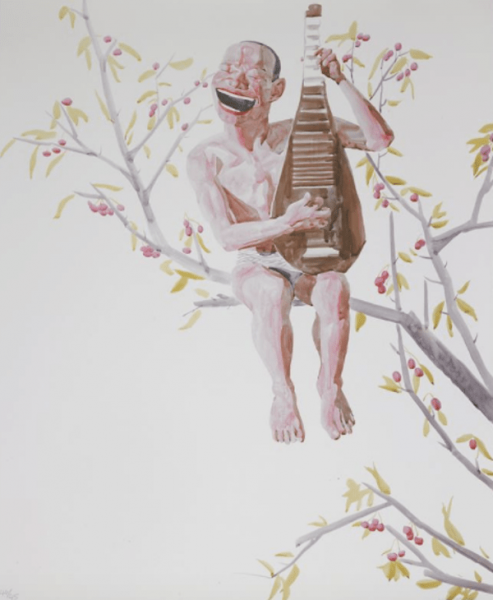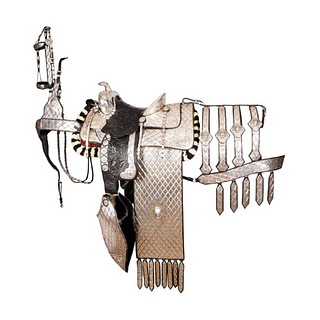Hey, Yue Minjun! What's so funny?
We're not laughing at you, we're laughing with you! Really? Sometimes it's hard to tell. Decoding the human experience through somatic expression, specifically, laughter doesnt always arise from a place of true comprehension - these reactions can come from a multitude of misinterpretations - like knowingly driving through a chatter of half-patched potholes. A plastered smile can act as a camouflage for ones deepest anxieties - a different problem for every overexposed tooth. The latter is especially noticeable when the wattage is on full blast and nobody has cracked open this mouthy metaphor wider than Yue Minjun, Chinas leading Contemporary artist.
This spring, Rago Auctions will be offering six of Yue Minjuns iconic "laughing man" self portraits in their Post War & Contemporary Art sale on May 6th - each lithograph depicting Yue Minjun and his doppelgängers hysterically laughing in seemingly random places and positions. So, what's so funny?
Although, his self portraiture has gained international recognition and acclaim, Minjun can’t seem to bottle his product smoothly enough for some critics. Often categorized as a “cynical realist,” he continues to remind viewers not to fixate on the political attachments that many wish to define his work by. This term "cynical realism" was used to describe the satirical juxtaposition between consumer capitalism with Chinese communism. As an emerging Chinese artists in the 1990’s - his most notable work, “The Execution,” (1995) painted in response to the Tiananmen Square Massacre, which killed hundreds of civilian demonstrators, including students - set the tone for the maniacal grin brushed across the faces of Minjun’s seemingly unfazed men. Framing all of his works in this way can complicate their intent; are they smiling sarcastically? Is this one big joke? Is society “cracking up” in fits of mindless delirium?
Without the restriction of a political lens - Minjun's works can explore deeper existential observations. The artists insights reveal the seriousness behind all this smiling , “My work is to do with the fundamental agony of being human and the sense of confusion that comes with living in our society,” he stated before the opening of his 2012 public installation "The Tao of Laughter," in Harbour City - a shopping mall stuffed with designer brands in the heart of Hong Kong. Taking notice of a new wave of materialism and financial worship, Minjung hoped to connect with the masses in their new found "shopping temple," even if for one moment, as they compulsively harvested handbags.
Left to Right: Lot 817, Yue Minjun, Untitled (Smile-ism No. 11) Lithograph in colors, 2006; Lot 816, Yue Minjun, Untitled (Smile-ism No. 6) Lithograph in colors, 2006
The conscious choice to use himself as the catalyst for conceptual debate continues to elevate Minjuns artistic freedoms. By using himself, it is impossible to insult anyone or point the finger on those unwilling to partake in his humorous exorcism of existence. Some compositions take on fantastical turns like the lithograph on the left, Untitled (Smile-ism No.11) where his caricature is placed on the body of a centaur - a confusing yet laughable moment. As Yue Minjun has pointed out in the past, "If you are faced with a situation you cannot change, then laughter may be the only possible reaction.”
The interpretation of Yue Minjun's work has much to do with individual perspective. The resemblance and repetitious use of laughter in Buddhism, best seen on the chubby cheeks of the giggling Buddha, has also inspired Minjun's use of the exaggerated facial expression. Unpredictable moments can present themselves as both frightening and funny; like whitewater rafting for instance, one considers the small possibility of death in the rough waters yet as the boat advances, an indescribable laughter erupts all the way down the violent river.
Life might be illogical but that doesnt mean Minjun's paintings are. In an interview Minjun highlighted his investigation into the smile, “I’m actually trying to make sense of the world,” he said. “There’s nothing cynical or absurd in what I do.” In Buddhism, the ultimate state of enlightenment, or Nirvana, is regarded as the path to liberation from rebirth. Can our distracted society grasp a minimalist mindset such as this? Depending on the viewers state of mind, "Smile-ism" can either serve as a helpful piece of advance or a nonsensical taunt - remember- were not laughing at you, were laughing with you! One thing is for sure, if laughter is contagious so are these prints!
Click here to view Rago Auctions full Post War & Contemporary Art catalog on May 6th; Other featured contemporary artists include Damien Hirst, Gerhard Ricther, Eduardo Chillida, David Hockney, Silas Shabelewska, Robert Mapplethorpe and many others!
- Quilts as a 2025 Design Trend: A Celebration of American Heritage and Craftsmanship
- A Celebration of Sports History and Collectibles
- Antiques and the Arts Weekly Q&A: Allis Ghim
- The Thrill of Sports Memorabilia Auctions: A Collector’s Paradise
- Demystifying Coin Condition: A Guide to the Sheldon Grading Scale
- Snoopy & Friends: A “Peanuts” Auction at Revere
- Colorful Chinese Monochromes at Millea Bros
- 12 Holiday Gifts for the “Impossible to Buy For” on Bidsquare
- Alluring Art Objects and Accessories from the Estate of Chara Schreyer
- Kimball Sterling's One-Owner Outsider and Folk Art Collection Showcases Masters of the Unconventional



 EUR
EUR CAD
CAD AUD
AUD GBP
GBP MXN
MXN HKD
HKD CNY
CNY MYR
MYR SEK
SEK SGD
SGD CHF
CHF THB
THB

















